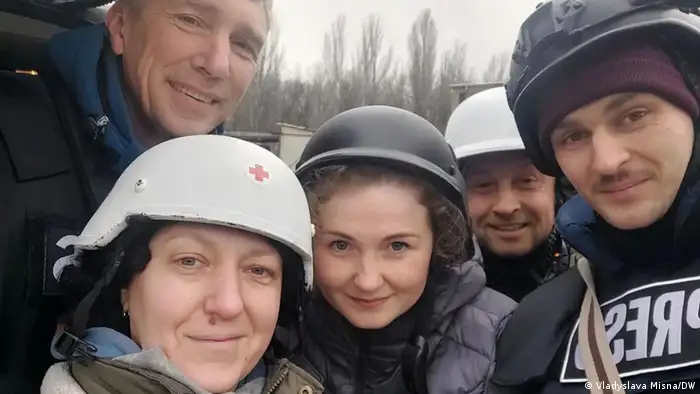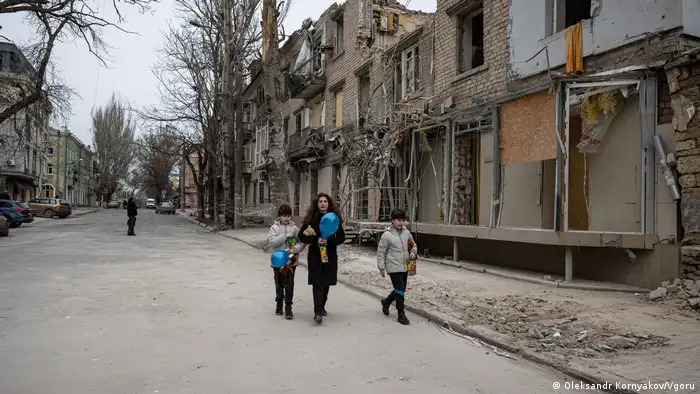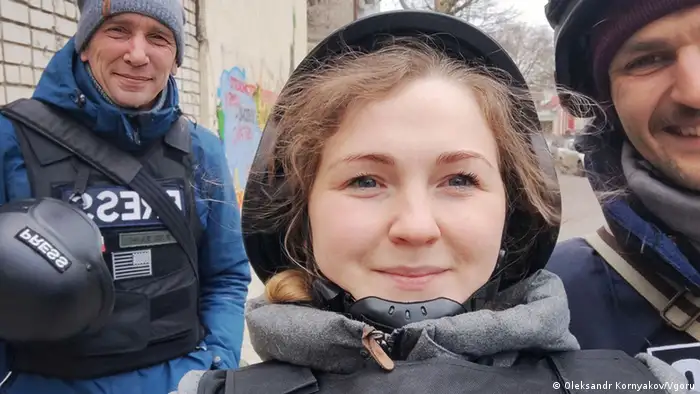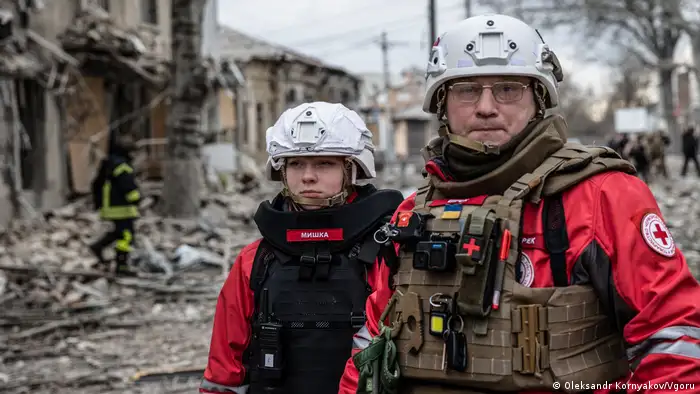Europe/Central Asia
Ukrainian media continues to develop two years into the invasion
Upon the anniversary of the Russian invasion of Ukraine, DW Akademie looks back on the work local media have accomplished amid incredible adversity.
From occupied to liberated, flooded and shelled, Kherson is emblematic of the Ukrainian experience since the Russian invasion. The city and region of the same name have endured countless existential threats over the past two years.
With Kherson capitulating on March 1, 2022, less than a week after the full Russian invasion, Ukraine’s southern region was the first to feel the war's devastation. Many Ukrainians living in the region, including some journalists, had no choice but to flee.
"The Russian military was targeting journalists," recalled Ilona Korotitsyna, media director for Vgoru, a small media outlet that covers the region. "They offered media schools and wanted media to work with them."
Many who did not attend the media schools, such as Korotitsyna and her colleagues at Vgoru, faced an unspoken ultimatum: Join or be targeted themselves. Korotitsyna and Vgoru reporter Liza Zharkykh decided they had no choice but to relocate to nearby cities.
Navigating occupation
Despite the new logistical hurdles, Vgoru continued to report on what was happening in the region. An independent media outlet of less than thirty people, they tried their best to inform citizens about occupied Kherson.
Yet reports were scant. Contacts risked their freedom and potentially their lives to send out any information they could record.
"We mostly only received photos," Zharkykh explained when reflecting on the war's early months. "It was too dangerous to record videos."
After the Ukrainian offensive in November 2022, Russia was forced to the Dnipro River's left (southeastern) bank, meaning that the city of Kherson was liberated. It was a moment of triumph for Ukraine, although Kherson's troubles were far from over.
"When the Russians left Kherson, they left the city with no electricity, no water, no communications," Zharkykh said.
Slowly, the city began to function again and the Vgoru team was able to return to work in their home city.
The left bank floods
Despite the Ukrainian military's successes, the region of Kherson remains a place of constant fighting. The Russian military is just across the Dnipro, within sight and still controlling the left bank.
Things went from bad to worse for those still under Russian occupation when, in June, Kakhovka hydroelectric power plant was destroyed. The Dnipro River's dam broke and the Russian-controlled left bank flooded, destroying 40 townships on the southern side and creating an ecological disaster.
"Many houses sat for months in a meter of water," said Zharkykh, who receives information from the left bank only over anonymous and open sources.
On the northeastern right bank, the city remains on the front lines even today, with only the occasional update via the social messenger Telegram from the far shore. Shells pound the city daily. Less than a third of the city's residents remain.
"There is very little work, schools and kindergartens are closed," Korotitsyna said. "Nevertheless, the city is a miracle and ordinary utility workers, shopkeepers and bus drivers have become real heroes."
Supporting independent media
Throughout it all, Vgoru has been able to keep investigating and publishing stories for Kherson and its diaspora.
But Korotitsyna, Zharkykh and the Vgoru team struggle to keep their doors open. The war caused its advertising revenue to dry up at the outset of the invasion, with little chance of returning to pre-war levels anytime soon.
But with the MediaFit project, funded by the European Union and supported by the Federal Ministry for Economic Cooperation and Development (BMZ), Vgoru has been able to stay in production. A new website is in the works and their recently produced documentary called “Unconquered Kherson” has been screened across Ukraine and internationally.
MediaFit, a joint project from DW Akademie, Canal France International and the Lithuanian public broadcaster LRT, has been working to support independent and local media, specifically in Ukraine’s Southern and Eastern regions.
Focusing on media viability, the project provides grants, tailored consultancy and training opportunities to 14 media outlets, which has helped to keep independent media alive and even developing in regions with very little advertising or other revenue streams available.
"While the financial support we provide to Ukrainian media as grants is vital for them for the time being, the media organizations we work with will enjoy positive results of the knowledge we share with them for years to come," said MediaFit Project Manager Yana Naralska.
Developing capacities
DW Akademie has also been working to increase capacities though other projects supported by the BMZ. The team has been collaborating with local partners in the country since 2014 to train hundreds of media workers and develop higher education projects throughout Ukraine. From cyber security to mental health, these projects are developing a network of journalists that spans the country.
"We want to build a community of media workers across Ukraine," said Program Director Kyryl Savin, "while strengthening hyperlocal and local media and encouraging plurality in the region."
The type of development provided by MediaFit and DW Akademie's BMZ projects can be a complex and challenging process, yet the gains have been significant.
MediaFit partners like Vgoru are examples of great perseverance over the past two years. Vgoru's team has continued to cover the region and give a local perspective that is required to understand life in Kherson today – for its residents and for those far from the front lines.
DW recommends
- Date 23.02.2024
- Author Alex Bodine
- Feedback: Send us your feedback.
- Print Print this page
- Permalink https://p.dw.com/p/4cn4Q
- Date 23.02.2024
- Author Alex Bodine
- Send us your feedback.
- Print Print this page
- Permalink https://p.dw.com/p/4cn4Q




